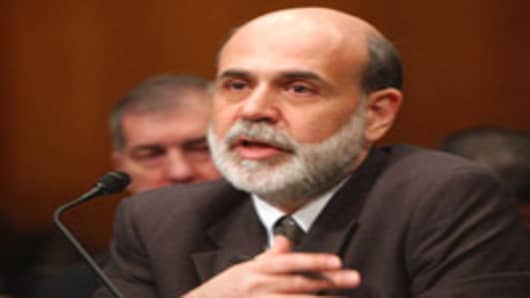Just when the markets thought the economy was getting better, Federal Reserve Chairman Ben Bernanke came out with a reminder Monday that the labor market remains weak and that the Fed could still do more easing if needed.
In a speech to the National Association for Business Economics ahead of the market open, Bernanke left the door open to more quantitative easing but without actually promising any more.
While not a departure from his previous comments, traders took Bernanke's speech to mean that Fed action is still a strong possibility.
The Fed chief's comments sent stocks higher, the dollar lower, andbond yields lower.
“Bernanke effectively advised the markets you need to keep some odds in,” said David Ader, chief Treasury strategist at CRT Capital.
In his speech, Bernanke discussed the weak labor marketand said the economy needs to grow faster if it is going to create enough jobs to reduce unemployment.
”He defended Fed policy, leaving without question the door open to QE3, if not in April, then in June,” said Tony Crescenzi, Pimco portfolio manager and market strategist. “Clearly, Bernanke still has an easing bias. This emphasis on long term unemployment shows it.”
Markets have been calculating reduced chances for a third round of quantitative easing after Bernanke's less dovish comments in congressional testimony earlier this month. The Fed’s post-meeting statement March 13 also gave a nod to an improving economy without expanding on further easing.
That has led some investors to believe that the Fed will not hold rates at near-zero until the end of 2014, as its members have forecast.
Traders expect the April FOMC meeting to be significant, in that the Fed may reveal whether it plans to continue “operation twist” or do a third round of asset purchases, a so-called QE3. Operation Twist, set to expire in June, is a program under which the Fed buys long-dated Treasurys and sells the short end in an attempt to hold rates low.
Stocks were up sharply at midday on the idea of more easing, but the market has been rising even as interest rates have risen on the lessened expectations for easing.
“The equity market may finally be coming around to the fact that a shorter time with low interest rates may be a positive,” said Art Hogan of Lazard Capital Markets. “The bond market may be confused in its reaction. I don’t think (Bernanke) he’s opened any windows here.”
The Fed has also said depending on the performance of the economy, it could carry out QE3, focusing on mortgage-backed securities rather than Treasurys in the next round.
Bernanke Monday said the improvement in the unemployment rate—to 8.3 percent—is out of sync with the modest pace of economic growth.
“To the extent that this reversal has been complete, further significant improvements in the unemployment rate will likely require a more rapid expansion of production and demand from consumers and businesses, a process that can be supported by continued accommodative policies,” Bernanke said.
Pimco's Crescenzi said Bernanke did not break new ground in his speech but basically supported the Fed’s current easing policies.
“It was the case for further accommodation but not necessarily because at the minimum, the speech was more about defending current policy and again, not advocating more,” Crescenzi said.
CRT Capital's Ader said the bond market had moved in the past several weeks to a place where it is factoring in 50/50 odds of more easing, down from 60/40 prior to Bernanke’s recent testimony and the FOMC meeting earlier this month.
“I don’t think the bond market is in a position to make a big bet either way,” said Ader.
“He’s (Bernanke) not giving us a lot more. He’s not taking away a lot more…He’s still got his concerns about where the Fed must stay cautious. That’s a big deal and it gets us back to watching and waiting,” Ader said. “In the last couple of weeks, the data has shifted from more positive to less positive, particularly on the housing front.”
Bernanke has said it would be a mistake to tighten too quickly. While lecturing a class of graduate students at George Washington University, Bernanke last week reminded them of the return of recession in 1937 after officials tightened policy too quickly after the Great Depression.
Boris Schlossberg of GFT Forex said the move in yields, after Bernanke’s comments was dollar bearish. QE is seen as dollar negative and a positive for risk assets.
“On the last couple of outings, he recognized the improvement in labor. Today, he deconstructed the improvement in the labor market and his deconstruct was not that it was from the improvement in the economy but that it was a replacement of too many jobs lost in the great recession,” he said. “Basically, the Fed is far, far more concerned about the employment mandate than anything, which leaves the door open for more monetary stimulus.”
Follow Patti Domm on Twitter: @pattidomm
Questions? Comments? Email us at marketinsider@cnbc.com




